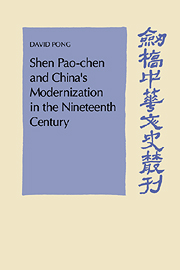Book contents
- Frontmatter
- Contents
- List of maps, tables, and figure
- Acknowledgements
- A note on spelling
- Abbreviations used in the notes
- Introduction
- 1 Early years
- 2 Local official in Kiangsi, 1856–1859
- 3 Governor of Kiangsi, 1862–1865
- 4 First encounters with foreigners
- 5 Director-general of the Foochow Navy Yard
- 6 The Foochow Navy Yard: early developments, 1866—1867
- 7 The Foochow Navy Yard: administration and personnel
- 8 The Foochow Navy Yard: building and training programmes
- 9 The Foochow Navy Yard: financial crises
- 10 The next steps in defence modernization: Ma-wei and beyond
- 11 Towards a plan for self-strengthening
- Conclusion
- Glossary of Chinese characters
- Bibliography
- Index
Conclusion
Published online by Cambridge University Press: 22 September 2009
- Frontmatter
- Contents
- List of maps, tables, and figure
- Acknowledgements
- A note on spelling
- Abbreviations used in the notes
- Introduction
- 1 Early years
- 2 Local official in Kiangsi, 1856–1859
- 3 Governor of Kiangsi, 1862–1865
- 4 First encounters with foreigners
- 5 Director-general of the Foochow Navy Yard
- 6 The Foochow Navy Yard: early developments, 1866—1867
- 7 The Foochow Navy Yard: administration and personnel
- 8 The Foochow Navy Yard: building and training programmes
- 9 The Foochow Navy Yard: financial crises
- 10 The next steps in defence modernization: Ma-wei and beyond
- 11 Towards a plan for self-strengthening
- Conclusion
- Glossary of Chinese characters
- Bibliography
- Index
Summary
In the Introduction we identified four stages in the history of reform in the last hundred years or so of the Ch'ing. These stages often overlapped, and a reformer could easily graduate from one to the next, thus highlighting the continuity of that reform tradition. The first stage was ushered in by members of the School of Practical Statecraft, who diagnosed the dynastic decline. They expressed their concern by diligently attending to administrative details and public works and were not afraid to tamper with time-honoured but ineffective institutions. Theirs was a response to an internal crisis.
By the 1830s and 1840s, some of these scholar-officials, now joined by others, began to react to the new threat from the West. Patriotic sentiments emerged, as did the idea of adopting Western military technology to curb foreign encroachments. But it is often overlooked that they also advocated a selective renovation of inherited institutions in order to accommodate and maximize the benefits of the new technology. The civil service examination system, one of the most sacrosanct institutions of the state, was a main target of reform. This willingness to modify traditional institutions and practices greatly adds to the significance of this second phase of reform.
When Shen began his education, he was exposed only to the practical statecraft ideas of the first stage. When he came of age, the reform ideas of the first two stages had already merged into a single tradition.
- Type
- Chapter
- Information
- Publisher: Cambridge University PressPrint publication year: 1994
- 1
- Cited by



